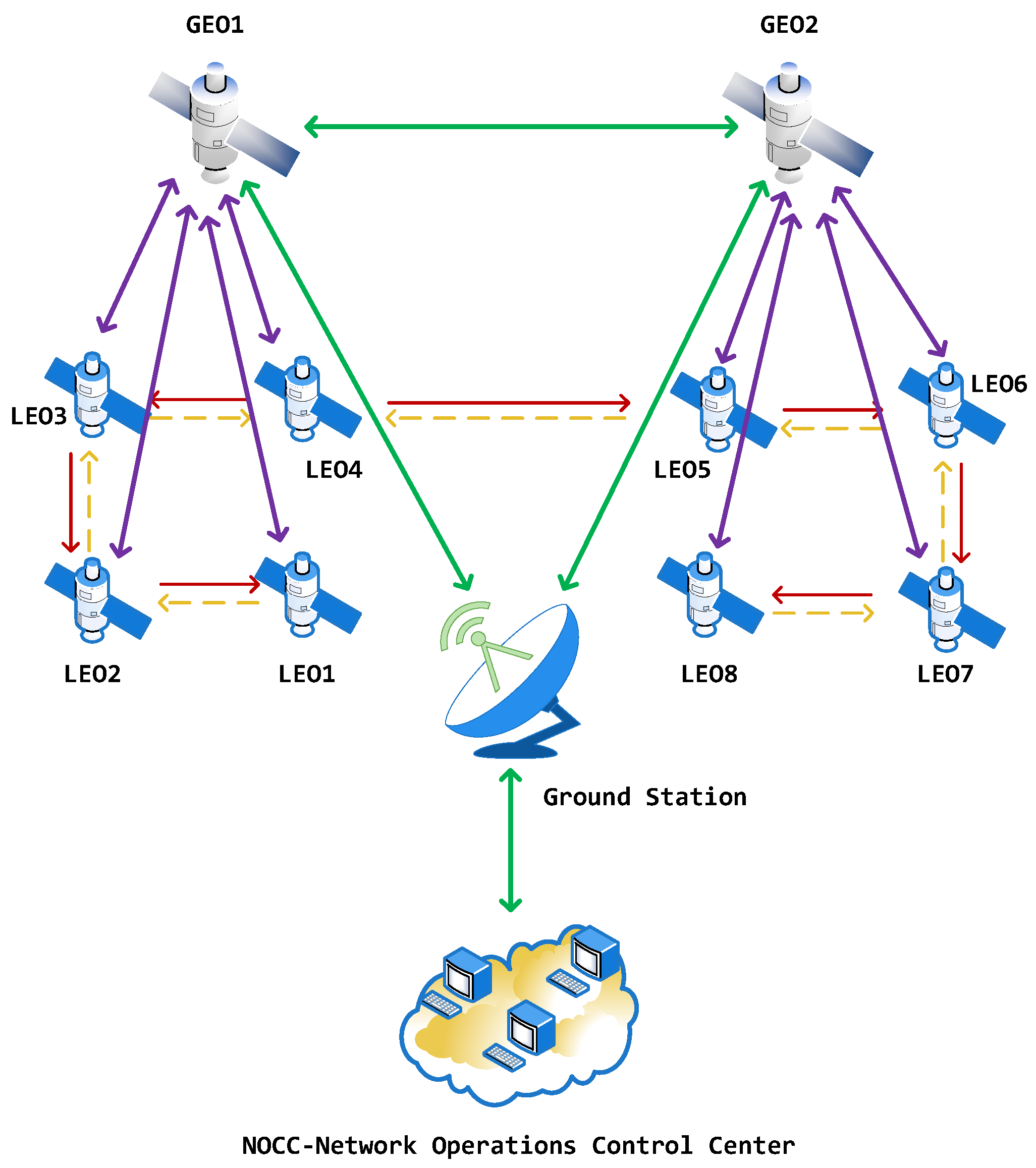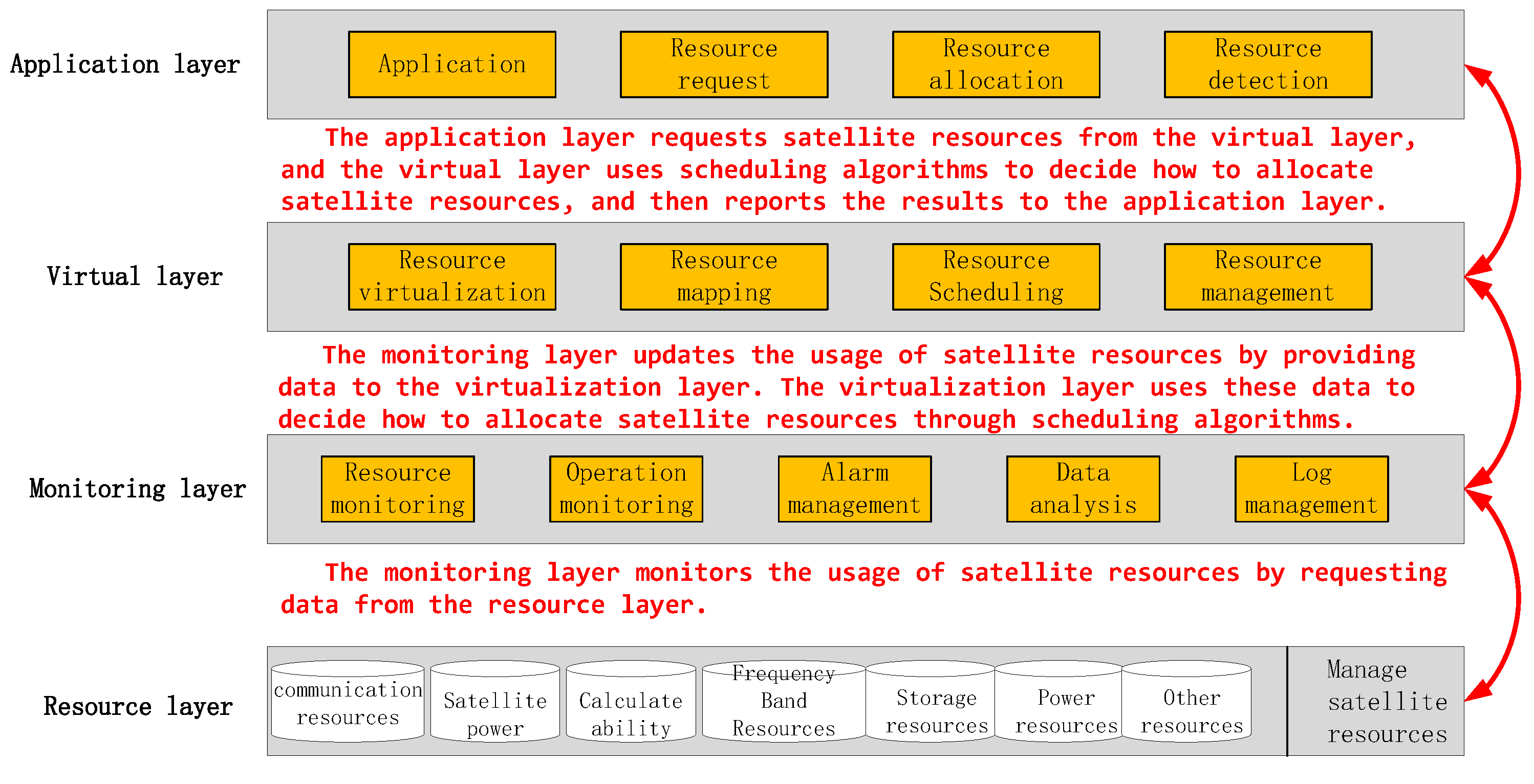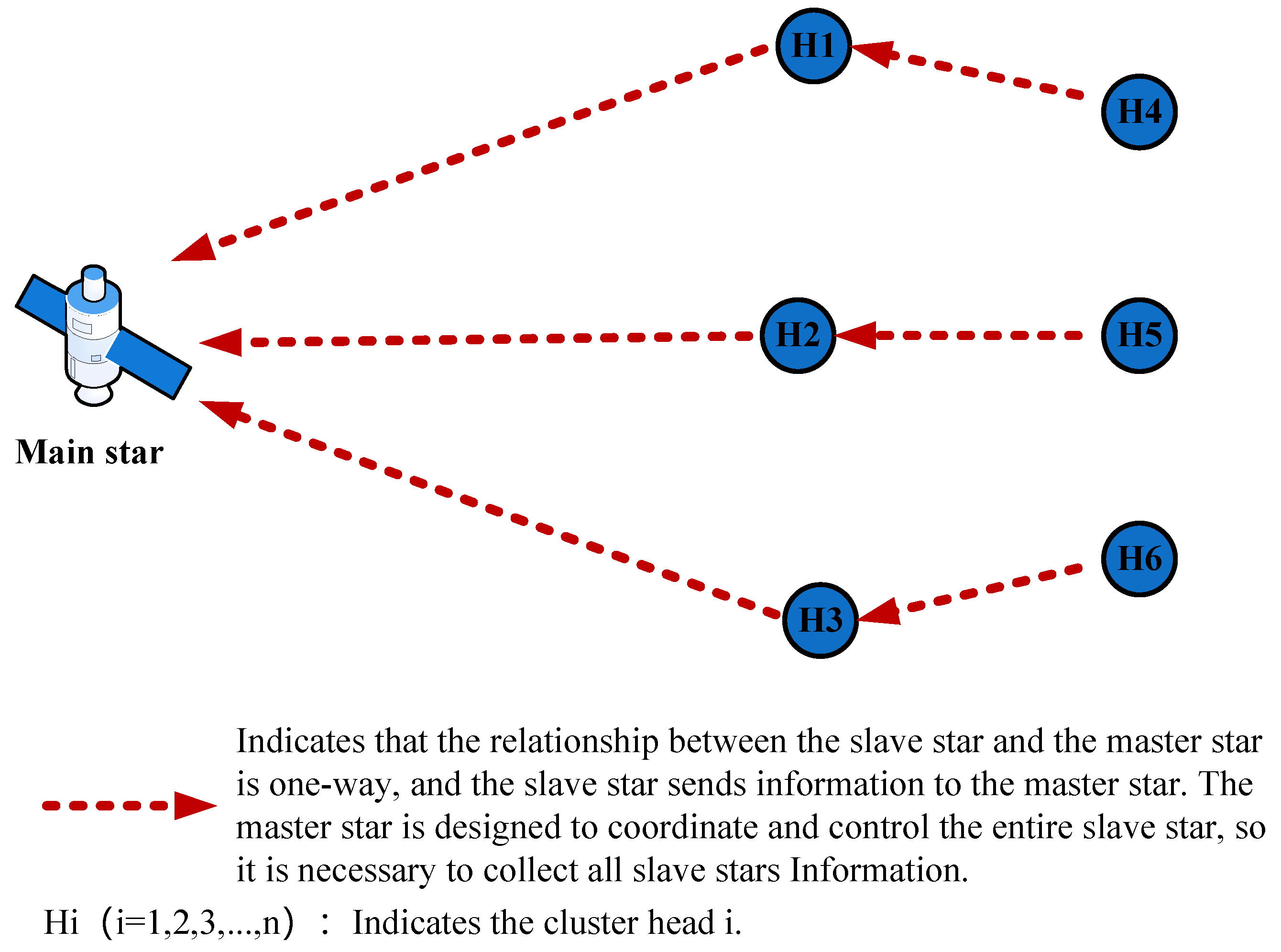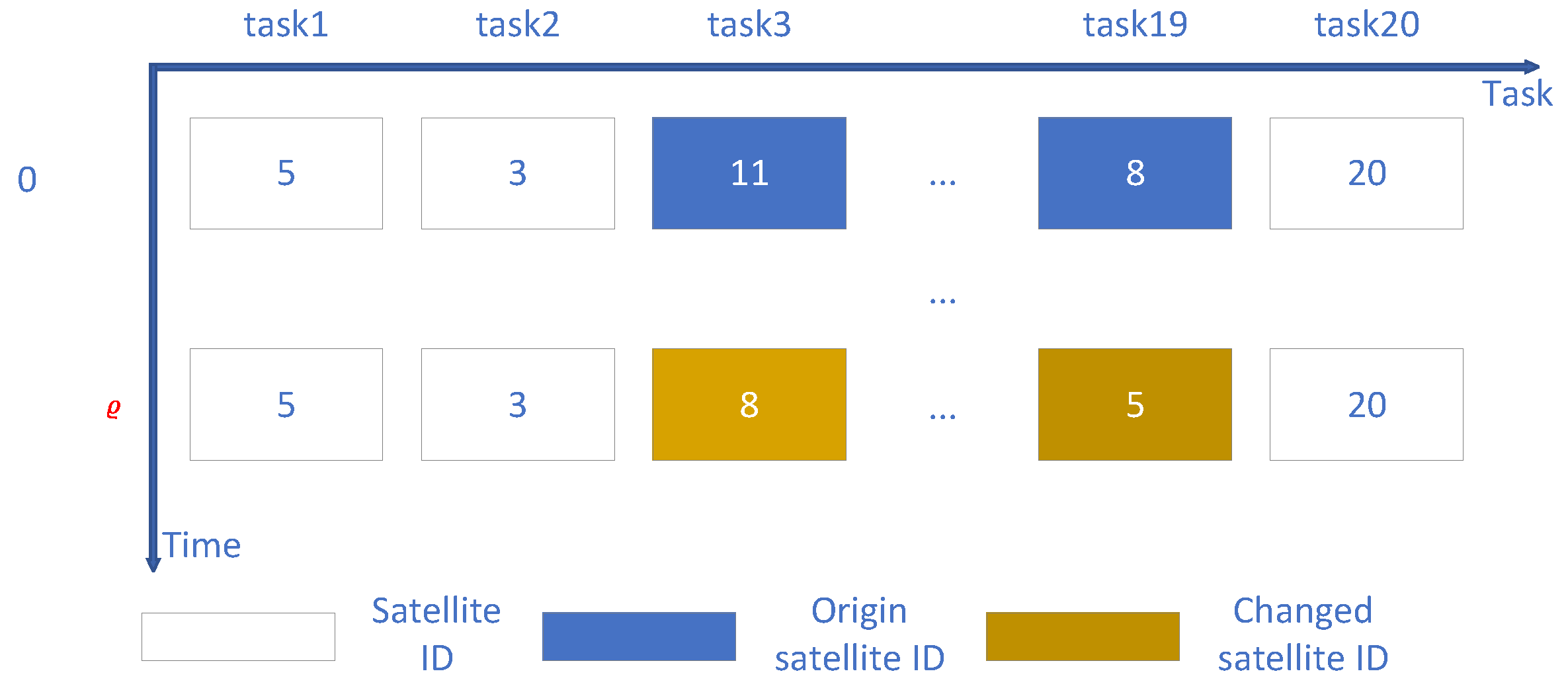Dynamic Network Resource Autonomy Management and Task Scheduling Method
Abstract
1. Introduction
2. Related Work
3. Dynamic Resource Management Architecture and Task Scheduling Method
3.1. Dynamic Resource Management Architecture
3.2. Dynamic Graph Construction Based on Local Satellite Networks
3.3. Satellite Mission Scheduling
| Algorithm 1: Highest Priority Scheduling |
 |
4. Simulation Experiments
4.1. Simulation Platform and Data
4.2. Numerical Comparative Analysis
5. Conclusions
Author Contributions
Funding
Institutional Review Board Statement
Informed Consent Statement
Data Availability Statement
Conflicts of Interest
References
- Wang, Y.; Sheng, M.; Ye, Q.; Zhang, S.; Zhuang, W.; Li, J. Optimal Dynamic Multi-Resource Management in Earth Observation Oriented Space Information Networks. arXiv 2019, arXiv:1907.12717. [Google Scholar]
- Sheng, M.; Wang, Y.; Li, J.; Liu, R.; Zhou, D.; He, L. Toward a flexible and reconfigurable broadband satellite network: Resource management architecture and strategies. IEEE Wirel. Commun. 2017, 24, 127–133. [Google Scholar] [CrossRef]
- Ferrús, R.; Koumaras, H.; Sallent, O.; Agapiou, G.; Rasheed, T.; Kourtis, M.A.; Boustie, C.; Gélard, P.; Ahmed, T. SDN/NFV-enabled satellite communications networks: Opportunities, scenarios and challenges. Phys. Commun. 2016, 18, 95–112. [Google Scholar] [CrossRef]
- Wu, H.; Chen, J.; Zhou, C.; Shi, W.; Cheng, N.; Xu, W.; Zhuang, W.; Shen, X.S. Resource management in space-air-ground integrated vehicular networks: SDN control and AI algorithm design. IEEE Wirel. Commun. 2020, 27, 52–60. [Google Scholar] [CrossRef]
- Miao, Y.; Cheng, Z.; Li, W.; Ma, H.; Liu, X.; Cui, Z. Software defined integrated satellite-terrestrial network: A survey. In Proceedings of the International Conference on Space Information Network, Yinchuan, China, 10–11 August 2017; Springer: Berlin/Heidelberg, Germany, 2017; pp. 16–25. [Google Scholar]
- Xie, G.; Liu, L.; Yang, L.; Li, R. Scheduling trade-off of dynamic multiple parallel workflows on heterogeneous distributed computing systems. Concurr. Comput. Pract. Exp. 2017, 29, e3782. [Google Scholar] [CrossRef]
- Yang, B.; Wu, Y.; Chu, X.; Song, G. Seamless handover in software-defined satellite networking. IEEE Commun. Lett. 2016, 20, 1768–1771. [Google Scholar] [CrossRef]
- Shi, Y.; Cao, Y.; Liu, J.; Kato, N. A cross-domain SDN architecture for multi-layered space-terrestrial integrated networks. IEEE Netw. 2019, 33, 29–35. [Google Scholar] [CrossRef]
- Li, T.; Zhou, H.; Luo, H.; Yu, S. SERvICE: A software defined framework for integrated space-terrestrial satellite communication. IEEE Trans. Mob. Comput. 2017, 17, 703–716. [Google Scholar] [CrossRef]
- Du, J.; Jiang, C.; Qian, Y.; Han, Z.; Ren, Y. Resource allocation with video traffic prediction in cloud-based space systems. IEEE Trans. Multimed. 2016, 18, 820–830. [Google Scholar] [CrossRef]
- El Sabbagh, E.M.; Hussein, M.; Elbayoumy, A.D. Enhancing the End-to-end Link Performance of Traditional Satellite Ground Networks via Software-Defined Networking Controllers (POX/RYU). Int. J. Comput. Appl. 2020, 975, 8887. [Google Scholar]
- Guo, Q.; Gu, R.; Dong, T.; Yin, J.; Liu, Z.; Bai, L.; Ji, Y. SDN-based end-to-end fragment-aware routing for elastic data flows in LEO satellite-terrestrial network. IEEE Access 2018, 7, 396–410. [Google Scholar] [CrossRef]
- Liu, R.; Sheng, M.; Lui, K.S.; Wang, X.; Wang, Y.; Zhou, D. An analytical framework for resource-limited small satellite networks. IEEE Commun. Lett. 2015, 20, 388–391. [Google Scholar] [CrossRef]
- Bao, J.; Zhao, B.; Yu, W.; Feng, Z.; Wu, C.; Gong, Z. OpenSAN: A software-defined satellite network architecture. ACM SIGCOMM Comput. Commun. Rev. 2014, 44, 347–348. [Google Scholar] [CrossRef]
- Fraire, J.A.; Madoery, P.G.; Finochietto, J.M. Traffic-aware contact plan design for disruption-tolerant space sensor networks. Ad Hoc Netw. 2016, 47, 41–52. [Google Scholar] [CrossRef]
- Wang, P.; Li, H.; Zhang, S.; Lin, X.; Liu, J.; Wang, E. A Novel Joint Scheduling Scheme of Earth Observation and Transmission in Satellite Networks. In Proceedings of the 2020 International Conference on Computing, Networking and Communications (ICNC), Big Island, HI, USA, 17–20 February 2020; pp. 774–779. [Google Scholar]
- Li, T.; Zhou, H.; Luo, H.; Quan, W.; Yu, S. Modeling software defined satellite networks using queueing theory. In Proceedings of the 2017 IEEE International Conference on Communications (ICC), Paris, Italy, 21–25 May 2017; pp. 1–6. [Google Scholar]
- Li, T.; Zhou, H.; Luo, H.; Xu, Q.; Ye, Y. Using SDN and NFV to implement satellite communication networks. In Proceedings of the 2016 International Conference on Networking and Network Applications (NaNA), Hokkaido, Japan, 23–25 July 2016; pp. 131–134. [Google Scholar]
- Zhou, D.; Sheng, M.; Wang, X.; Xu, C.; Liu, R.; Li, J. Mission aware contact plan design in resource-limited small satellite networks. IEEE Trans. Commun. 2017, 65, 2451–2466. [Google Scholar] [CrossRef]
- Wang, Y.; Sheng, M.; Zhuang, W.; Zhang, S.; Zhang, N.; Li, J. Joint scheduling of observation and transmission in earth observation satellite networks. In Proceedings of the GLOBECOM 2017–2017 IEEE Global Communications Conference, Singapore, 4–8 December 2017; pp. 1–6. [Google Scholar]
- Wang, Y.; Sheng, M.; Li, J.; Wang, X.; Liu, R.; Zhou, D. Dynamic contact plan design in broadband satellite networks with varying contact capacity. IEEE Commun. Lett. 2016, 20, 2410–2413. [Google Scholar] [CrossRef]
- Zhou, D.; Sheng, M.; Li, B.; Li, J.; Han, Z. Distributionally robust planning for data delivery in distributed satellite cluster network. IEEE Trans. Wirel. Commun. 2019, 18, 3642–3657. [Google Scholar] [CrossRef]
- He, L.; Li, J.; Sheng, M.; Liu, R.; Guo, K.; Zhou, D. Dynamic scheduling of hybrid tasks with time windows in data relay satellite networks. IEEE Trans. Veh. Technol. 2019, 68, 4989–5004. [Google Scholar] [CrossRef]
- Ahmed, T.; Dubois, E.; Dupé, J.B.; Ferrús, R.; Gélard, P.; Kuhn, N. Software-defined satellite cloud RAN. Int. J. Satell. Commun. Netw. 2018, 36, 108–133. [Google Scholar] [CrossRef]
- Bhoyar, D.; Kadam, M.; Sarode, P. Review of Software Defined Integrated Satellite-Terrestrial Network. In ICCCE 2019; Springer: Berlin/Heidelberg, Germany, 2020; pp. 333–340. [Google Scholar]
- Wang, Y.; Sheng, M.; Zhuang, W.; Zhang, S.; Zhang, N.; Liu, R.; Li, J. Multi-resource coordinate scheduling for earth observation in space information networks. IEEE J. Sel. Areas Commun. 2018, 36, 268–279. [Google Scholar] [CrossRef]
- Du, J.; Jiang, C.; Wang, J.; Yu, S.; Ren, Y. Stability analysis and resource allocation for space-based multi-access systems. In Proceedings of the 2015 IEEE Global Communications Conference (GLOBECOM), San Diego, CA, USA, 6–10 December 2015; pp. 1–6. [Google Scholar]
- Sheng, M.; Zhou, D.; Liu, R.; Wang, Y.; Li, J. Resource mobility in space information networks: Opportunities, challenges, and approaches. IEEE Netw. 2018, 33, 128–135. [Google Scholar] [CrossRef]
- Liang, Q.; Fan, Y.; Yan, X.; Yan, Y. An algorithm based on differential evolution for satellite data transmission scheduling. Int. J. Comput. Sci. Eng. 2019, 18, 279–285. [Google Scholar] [CrossRef]
- Wei, Z.; Zhao, B. A Space Information Service Forwarding Mechnism Based on Software Defined Network. J. Internet Serv. Inf. Secur. 2017, 7, 48–60. [Google Scholar]
- Feng, B.; Zhou, H.; Zhang, H.; Li, G.; Li, H.; Yu, S.; Chao, H.C. HetNet: A flexible architecture for heterogeneous satellite-terrestrial networks. IEEE Netw. 2017, 31, 86–92. [Google Scholar] [CrossRef]
- Du, J.; Jiang, C.; Guo, Q.; Guizani, M.; Ren, Y. Cooperative earth observation through complex space information networks. IEEE Wirel. Commun. 2016, 23, 136–144. [Google Scholar] [CrossRef]
- Li, T.; Zhou, H.; Luo, H.; You, I.; Xu, Q. SAT-FLOW: Multi-strategy flow table management for software defined satellite networks. IEEE Access 2017, 5, 14952–14965. [Google Scholar] [CrossRef]
- Li, T.; Zhou, H.; Luo, H.; Quan, W.; Xu, Q.; Li, G.; Li, G. Timeout strategy-based mobility management for software defined satellite networks. In Proceedings of the 2017 IEEE Conference on Computer Communications Workshops (INFOCOM WKSHPS), Virtual, 1–4 May 2017; pp. 319–324. [Google Scholar]
- Zhou, D.; Sheng, M.; Liu, R.; Wang, Y.; Li, J. Channel-aware mission scheduling in broadband data relay satellite networks. IEEE J. Sel. Areas Commun. 2018, 36, 1052–1064. [Google Scholar] [CrossRef]
- Zhou, D.; Sheng, M.; Li, J.; Xu, C.; Liu, R.; Wang, Y. Toward high throughput contact plan design in resource-limited small satellite networks. In Proceedings of the 2016 IEEE 27th Annual International Symposium on Personal, Indoor, and Mobile Radio Communications (PIMRC), Valencia, Spain, 4–8 September 2016; pp. 1–6. [Google Scholar]
- Xu, S.; Wang, X.W.; Huang, M. Software-defined next-generation satellite networks: Architecture, challenges, and solutions. IEEE Access 2018, 6, 4027–4041. [Google Scholar] [CrossRef]
- Bertaux, L.; Medjiah, S.; Berthou, P.; Abdellatif, S.; Hakiri, A.; Gelard, P.; Planchou, F.; Bruyere, M. Software defined networking and virtualization for broadband satellite networks. IEEE Commun. Mag. 2015, 53, 54–60. [Google Scholar] [CrossRef]
- Fan, H.; Yang, Z.; Zhang, X.; Wu, S.; Long, J.; Liu, L. A novel multi-satellite and multi-task scheduling method based on task network graph aggregation. Expert Syst. Appl. 2022, 205, 117565. [Google Scholar] [CrossRef]
- Tan, S.; Jin, F.; Xie, J.; Dun, C. A QoE Driven Cross-Domain Management Architecture for Space-Air-Ground Integrated Network. Wirel. Commun. Mob. Comput. 2022, 2022, 1–14. [Google Scholar] [CrossRef]
- Bi, Y.; Han, G.; Xu, S.; Wang, X.; Lin, C.; Yu, Z.; Sun, P. Software defined space-terrestrial integrated networks: Architecture, challenges, and solutions. IEEE Netw. 2019, 33, 22–28. [Google Scholar] [CrossRef]
- Fan, H.; Yang, Z.; Wu, S.; Zhang, X.; Long, J.; Liu, L. An Efficient Satellite Resource Cooperative Scheduling Method on Spatial Information Networks. Mathematics 2021, 9, 3293. [Google Scholar] [CrossRef]
- Fan, H.; Long, J.; Liu, L.; Yang, Z. Dynamic Digital Twin and Online Scheduling for Contact Window Resources in Satellite Network. IEEE Trans. Ind. Inform. 2022, 1–10. [Google Scholar] [CrossRef]
- San Martin, L.S.; Yang, J.; Liu, Y. Hybrid NSGA III/dual simplex approach to generation and transmission maintenance scheduling. Int. J. Electr. Power Energy Syst. 2022, 135, 107498. [Google Scholar] [CrossRef]
- Chen, N.; Li, M.; Wang, M.; Su, Z.; Li, J.; Shen, X.S. A dynamic pricing based scheduling scheme for electric vehicles as mobile energy storages. In Proceedings of the ICC 2021-IEEE International Conference on Communications, Dublin, Ireland, 14–23 June 2021; pp. 1–6. [Google Scholar]
- Rashidi, H. Simulation and Evaluation of Network Simplex Algorithm and its Extensions for Vehicle Scheduling Problems in Ports. Int. J. Marit. Technol. 2019, 11, 1–12. [Google Scholar] [CrossRef]
- Zhang, Z.; Wu, W.; Yuan, J.; Du, D.Z. Breach-free sleep-wakeup scheduling for barrier coverage with heterogeneous wireless sensors. IEEE/ACM Trans. Netw. 2018, 26, 2404–2413. [Google Scholar] [CrossRef]
- Hossein-Nejad, Z.; Agahi, H.; Mahmoodzadeh, A. Image matching based on the adaptive redundant keypoint elimination method in the SIFT algorithm. Pattern Anal. Appl. 2021, 24, 669–683. [Google Scholar] [CrossRef]










| Configuration Items | Computer Configuration Information |
|---|---|
| Operating System | Windows 10 Family Chinese Version |
| CPU | Intel(R) Core(TM) i5-1035G1 CPU @ 1.00 GHz |
| Memory | 8 GB |
| Hard Disk | 512 GB |
| Video Cards | NVIDIA GeForce MX350 |
| DUNM | PS | DS | NS | Barrier | Sifting | |
|---|---|---|---|---|---|---|
| D1 | 0.465873 | 0.813586 | 0.841538 | 0.796589 | 0.802961 | 0.774817 |
| D2 | 0.591948 | 0.901514 | 0.865037 | 0.838193 | 0.851823 | 0.881752 |
| D3 | 0.733071 | 0.878968 | 0.892657 | 0.94071 | 0.904292 | 0.895728 |
| D4 | 0.893934 | 0.972274 | 0.899088 | 0.970249 | 0.898302 | 0.968244 |
| Data Set | Algorithm | Task Successfully Assigned | Failed to Assign Task | Total Revenue |
|---|---|---|---|---|
| D1 | DUNM | 42 | 0 | 51.53 |
| PS | 40 | 2 | 38.52 | |
| DS | 40 | 2 | 38.52 | |
| NS | 40 | 2 | 38.52 | |
| Barrier | 40 | 2 | 38.52 | |
| Sifting | 40 | 2 | 38.52 | |
| D2 | DUNM | 77 | 0 | 156.12 |
| PS | 65 | 12 | 82.7 | |
| DS | 65 | 12 | 82.7 | |
| NS | 65 | 12 | 82.7 | |
| Barrier | 65 | 12 | 82.7 | |
| Sifting | 65 | 12 | 82.7 | |
| D3 | DUNM | 102 | 0 | 161.63 |
| PS | 46 | 56 | 125.7 | |
| DS | 46 | 56 | 125.7 | |
| NS | 44 | 58 | 123.07 | |
| Barrier | 46 | 56 | 125.7 | |
| Sifting | 46 | 56 | 125.7 | |
| D4 | DUNM | 149 | 0 | 298.67 |
| PS | 62 | 87 | 121.4 | |
| DS | 62 | 87 | 121.4 | |
| NS | 62 | 87 | 121.4 | |
| Barrier | 63 | 86 | 121 | |
| Sifting | 61 | 88 | 120.95 |
| T1 | T2 | T3 | T4 | T5 | T6 | T7 | T8 | T9 | T10 | T1 | T2 | T3 | T4 | T5 | T6 | T7 | T8 | T9 | T10 | T1 | T2 | T3 | T4 | T5 | T6 | T7 | T8 | T9 | T10 | T1 | T2 | T3 | T4 | T5 | T6 | T7 | T8 | T9 | T10 | ||
|---|---|---|---|---|---|---|---|---|---|---|---|---|---|---|---|---|---|---|---|---|---|---|---|---|---|---|---|---|---|---|---|---|---|---|---|---|---|---|---|---|---|
| DUNM | assigned tasks | 8 | 16 | 21 | 31 | 4 | 6 | 10 | 0 | 3 | 7 | 9 | 30 | 4 | 7 | 8 | 15 | 4 | 6 | 8 | 12 | 2 | 7 | 7 | 11 | 3 | 6 | 11 | 13 | 5 | 6 | 9 | 12 | 4 | 8 | 9 | 11 | 5 | 8 | 10 | 14 |
| unassigned tasks | 0 | 0 | 0 | 0 | 0 | 0 | 0 | 18 | 0 | 0 | 0 | 0 | 0 | 0 | 0 | 0 | 0 | 0 | 0 | 0 | 0 | 0 | 0 | 0 | 0 | 0 | 0 | 0 | 0 | 0 | 0 | 0 | 0 | 0 | 0 | 0 | 0 | 0 | 0 | 0 | |
| Task revenue | 4.42 | 28.57 | 34.08 | 56.32 | 4.18 | 19.2 | 24.47 | 0 | 9.86 | 16.6 | 7.96 | 54.7 | 0.73 | 9.62 | 14.41 | 30.95 | 12.59 | 16.37 | 16.24 | 33.65 | 1.04 | 25.14 | 8.41 | 26.1 | 4.52 | 9.52 | 25.66 | 29.3 | 6.73 | 18.61 | 5.34 | 25.23 | 4.16 | 6.05 | 10.79 | 26.06 | 3.3 | 6.45 | 14.27 | 16.36 | |
| PS | assigned tasks | 4 | 6 | 4 | 6 | 4 | 7 | 4 | 6 | 6 | 8 | 6 | 9 | 5 | 7 | 5 | 8 | 3 | 5 | 4 | 5 | 3 | 6 | 4 | 5 | 3 | 8 | 6 | 8 | 4 | 5 | 4 | 4 | 4 | 7 | 4 | 6 | 4 | 6 | 5 | 5 |
| unassigned tasks | 4 | 10 | 17 | 25 | 4 | 9 | 23 | 37 | 1 | 8 | 26 | 40 | 0 | 8 | 29 | 47 | 1 | 9 | 33 | 54 | 0 | 10 | 36 | 60 | 0 | 8 | 41 | 65 | 1 | 9 | 46 | 73 | 1 | 10 | 51 | 78 | 2 | 12 | 56 | 87 | |
| Task revenue | 3.76 | 10.73 | 16 | 14.5 | 2.68 | 9.93 | 19.67 | 13.17 | 9.51 | 10.42 | 14 | 11.58 | 2.77 | 5.9 | 21.29 | 17.58 | 3.57 | 8.77 | 13 | 9.33 | 1.31 | 8.45 | 5.92 | 7.73 | 2.48 | 6.24 | 14.5 | 13.33 | 4.36 | 10.93 | 5.67 | 12 | 3.59 | 5.35 | 8.67 | 12.67 | 4.5 | 5.98 | 7 | 9.5 | |
| DS | assigned tasks | 4 | 6 | 4 | 6 | 4 | 7 | 4 | 6 | 6 | 8 | 6 | 9 | 5 | 7 | 5 | 8 | 3 | 5 | 4 | 5 | 3 | 6 | 4 | 5 | 3 | 8 | 6 | 8 | 4 | 5 | 4 | 4 | 4 | 7 | 4 | 6 | 4 | 6 | 5 | 5 |
| unassigned tasks | 4 | 10 | 17 | 25 | 4 | 9 | 23 | 37 | 1 | 8 | 26 | 40 | 0 | 8 | 29 | 47 | 1 | 9 | 33 | 54 | 0 | 10 | 36 | 60 | 0 | 8 | 41 | 65 | 1 | 9 | 46 | 73 | 1 | 10 | 51 | 78 | 2 | 12 | 56 | 87 | |
| Task revenue | 3.76 | 10.73 | 16 | 14.5 | 2.68 | 9.93 | 19.67 | 13.17 | 9.51 | 10.42 | 14 | 11.58 | 2.77 | 5.9 | 21.29 | 17.58 | 3.57 | 8.77 | 13 | 9.33 | 1.31 | 8.45 | 5.92 | 7.73 | 2.48 | 6.24 | 14.5 | 13.33 | 4.36 | 10.93 | 5.67 | 12 | 3.59 | 5.35 | 8.67 | 12.67 | 4.5 | 5.98 | 7 | 9.5 | |
| NS | assigned tasks | 4 | 6 | 4 | 6 | 3 | 7 | 4 | 6 | 6 | 8 | 4 | 9 | 5 | 7 | 5 | 8 | 3 | 5 | 4 | 5 | 4 | 6 | 4 | 5 | 3 | 8 | 6 | 8 | 4 | 5 | 4 | 4 | 4 | 7 | 5 | 6 | 4 | 6 | 4 | 5 |
| unassigned tasks | 4 | 10 | 17 | 25 | 5 | 9 | 23 | 37 | 2 | 8 | 28 | 40 | 1 | 8 | 31 | 47 | 2 | 9 | 35 | 54 | 0 | 10 | 38 | 60 | 0 | 8 | 43 | 65 | 1 | 9 | 48 | 73 | 1 | 10 | 52 | 78 | 2 | 12 | 58 | 87 | |
| Task revenue | 3.76 | 10.73 | 16 | 14.5 | 2.01 | 9.93 | 19.67 | 13.17 | 9.57 | 10.42 | 11 | 11.58 | 2.77 | 5.9 | 21.29 | 17.58 | 3.57 | 8.77 | 13 | 9.33 | 1.91 | 8.45 | 6.45 | 7.73 | 2.48 | 6.24 | 14.5 | 13.33 | 4.36 | 10.93 | 5.67 | 12 | 3.59 | 5.35 | 8.67 | 12.67 | 4.5 | 5.98 | 6.83 | 9.5 | |
| Barrier | assigned tasks | 4 | 6 | 4 | 6 | 4 | 7 | 4 | 6 | 6 | 8 | 6 | 9 | 5 | 7 | 5 | 8 | 3 | 5 | 4 | 5 | 3 | 6 | 4 | 5 | 3 | 8 | 6 | 8 | 4 | 5 | 4 | 4 | 4 | 7 | 4 | 6 | 4 | 6 | 5 | 6 |
| unassigned tasks | 4 | 10 | 17 | 25 | 4 | 9 | 23 | 37 | 1 | 8 | 26 | 40 | 0 | 8 | 29 | 47 | 1 | 9 | 33 | 54 | 0 | 10 | 36 | 60 | 0 | 8 | 41 | 65 | 1 | 9 | 46 | 73 | 1 | 10 | 51 | 78 | 2 | 12 | 56 | 86 | |
| Task revenue | 3.76 | 10.73 | 16 | 14.5 | 2.68 | 9.93 | 19.67 | 13.17 | 9.51 | 10.42 | 14 | 11.58 | 2.77 | 5.9 | 21.29 | 17.58 | 3.57 | 8.77 | 13 | 9.33 | 1.31 | 8.45 | 5.92 | 7.73 | 2.48 | 6.24 | 14.5 | 13.33 | 4.36 | 10.93 | 5.67 | 12 | 3.59 | 5.35 | 8.67 | 12.67 | 4.5 | 5.98 | 7 | 9.1 | |
| Sifting | assigned tasks | 4 | 6 | 4 | 6 | 4 | 7 | 4 | 6 | 6 | 8 | 6 | 8 | 5 | 7 | 5 | 8 | 3 | 5 | 4 | 5 | 3 | 6 | 4 | 6 | 3 | 8 | 6 | 7 | 4 | 5 | 4 | 4 | 4 | 7 | 4 | 6 | 4 | 6 | 5 | 5 |
| unassigned tasks | 4 | 10 | 17 | 25 | 4 | 9 | 23 | 37 | 1 | 8 | 26 | 41 | 0 | 8 | 29 | 48 | 1 | 9 | 33 | 55 | 0 | 10 | 36 | 60 | 0 | 8 | 41 | 66 | 1 | 9 | 46 | 74 | 1 | 10 | 51 | 79 | 2 | 12 | 56 | 88 | |
| Task revenue | 3.76 | 10.73 | 16 | 13.5 | 2.68 | 9.93 | 19.67 | 13.5 | 9.51 | 10.42 | 14 | 11.75 | 2.77 | 5.9 | 21.29 | 17.58 | 3.57 | 8.77 | 13 | 9.33 | 1.31 | 8.45 | 5.92 | 7.78 | 2.48 | 6.24 | 14.5 | 13.33 | 4.36 | 10.93 | 5.67 | 12 | 3.59 | 5.35 | 8.67 | 12.67 | 4.5 | 5.98 | 7 | 9.5 |
Disclaimer/Publisher’s Note: The statements, opinions and data contained in all publications are solely those of the individual author(s) and contributor(s) and not of MDPI and/or the editor(s). MDPI and/or the editor(s) disclaim responsibility for any injury to people or property resulting from any ideas, methods, instructions or products referred to in the content. |
© 2023 by the authors. Licensee MDPI, Basel, Switzerland. This article is an open access article distributed under the terms and conditions of the Creative Commons Attribution (CC BY) license (https://creativecommons.org/licenses/by/4.0/).
Share and Cite
Li, X.; Yang, J.; Fan, H. Dynamic Network Resource Autonomy Management and Task Scheduling Method. Mathematics 2023, 11, 1232. https://doi.org/10.3390/math11051232
Li X, Yang J, Fan H. Dynamic Network Resource Autonomy Management and Task Scheduling Method. Mathematics. 2023; 11(5):1232. https://doi.org/10.3390/math11051232
Chicago/Turabian StyleLi, Xiuhong, Jiale Yang, and Huilong Fan. 2023. "Dynamic Network Resource Autonomy Management and Task Scheduling Method" Mathematics 11, no. 5: 1232. https://doi.org/10.3390/math11051232
APA StyleLi, X., Yang, J., & Fan, H. (2023). Dynamic Network Resource Autonomy Management and Task Scheduling Method. Mathematics, 11(5), 1232. https://doi.org/10.3390/math11051232






